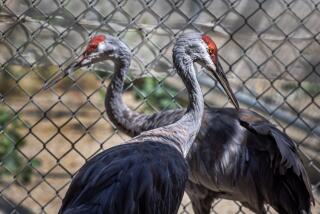Incredible Journey of the Santa Barbara 5
SANTA BARBARA — This is a city married to the mob. Of meerkats. Five funny, furry, almost fantastical creatures from the Santa Barbara Zoo that, in three short years of life, have been lent, lost, stolen, sold, found and rescued.
Their exploits involved tragedy, danger and notoriety. Their rescue entailed a trip in a private plane and, inevitably, commemorative T-shirts, plush action figures and a fan club. Now safe and healthy, they will slowly be reintroduced to the meerkat exhibit and to their eager, adoring public early next year.
“These are the most famous and, I suspect, the most expensive meerkats in history,” said Rich Block, the zoo’s director. He estimates that the zoo spent about $18,000 in legal fees and travel costs to rescue the animals.
“Now that we’ve got them back, they’re never leaving the zoo again.”
Meerkats, indigenous to Africa’s Kalahari Desert, are members of the mongoose family. At peace they’re known as a gang; in fight mode, they are a mob. They have raccoon-like faces, stand a foot tall, weigh about two pounds and have nimble, four-fingered paws with long claws for digging burrows and seeking prey: worms, crickets, grubs and scorpions.
On their bellies they have black skin, which absorbs heat when they sun themselves on chilly desert mornings, and on their backs spiky fur, which they arrange into a puff of insulation when the African sun gets too fierce. Because they are, as animal experts like to say, “snack size,” meerkats have evolved a complex, cooperative society, complete with baby-sitters, sentries, dozens of alarm calls and a deep distrust of strangers. Still, the mortality rate for adults in the wild can reach 50%. They live to be about 8 years old in the wild and 10 or more in captivity.
“They’re fascinating animals,” Block said. “Even before all this happened, they had quite a following.”
Santa Barbara’s meerkat epic began two years ago when the zoo lent the five meerkats to a facility in Texas. On Aug. 5, an investigative story in U.S. News and World Report about accredited zoos that sell excess animals to unaccredited facilities cited the Santa Barbara Zoo’s meerkats among the animals in an abandoned zoo in New Braunfels, Texas.
“After I got over the cardiac arrest, we sorted it out,” Block said. “By Wednesday of that week we hired a law firm in San Antonio to help us.”
The defunct Texas zoo’s owner said the meerkats, which the Santa Barbara Zoo still owned, had escaped or been stolen. But in early September, a persistent inspector with the U.S Department of Agriculture located them in the home of a private dealer, who had paid $200 each for the animals and was keeping them as pets.
“We called the dealer and he was willing to give them up,” Block said. “Within 90 minutes, they were in a holding facility at the San Antonio Zoo.”
The Santa Barbara Zoo has since amended its policy and will sell and lend animals only to accredited facilities.
On Nov. 3, in a plane owned and piloted by Santa Barbara dentist Jerry Woolf, the meerkats touched down at Santa Barbara Municipal Airport.
“It was a great trip -- a great group of people and a great cause,” said Dr. Alex Soffici, a perinatologist who co-piloted the plane and sometimes lends his own airplane to the zoo.
“I’d look back into the plane and see the guys handing the meerkats grapes and hard-boiled eggs, and you could see their little paws coming out of the pet carriers to get the food,” Soffici said.
When they all landed, however, they got a nasty shock. In about six hours that the meerkats had been separated, the animals, which have poor close-range vision and rely on smell for identification, had lost track of the group hierarchy. When handlers opened the pet carriers in the zoo’s holding facilities, the Santa Barbara Five, as the local paper had nicknamed them, went nuts.
“There was a lot of yelling and screaming and jumping on one another -- it was pretty intense,” said Alan Varsik, general curator at the zoo. “It looked and sounded very ferocious, but after about 20 minutes they sorted things out and went back to being the close group that they were.”
Which leads to one final problem now facing the zoo.
While the Santa Barbara Five were gone, the zoo opened a new 250-square-foot meerkat exhibit. Three meerkats now call the exhibit home. How to add five strangers and still keep the peace has zoo officials scratching their heads.
“We’re still talking about that one,” Varsik said. “We’ve got some ideas we’re going to try -- maybe rotate one group in and the other out, maybe introduce the new ones slowly.”
And when they finally make their debut, Varsik expects some meerkat mania.
“They were an obsession with this city for a while,” he said. “When they come back, we’re sure they’ll be headline news again.”
More to Read
Sign up for Essential California
The most important California stories and recommendations in your inbox every morning.
You may occasionally receive promotional content from the Los Angeles Times.










